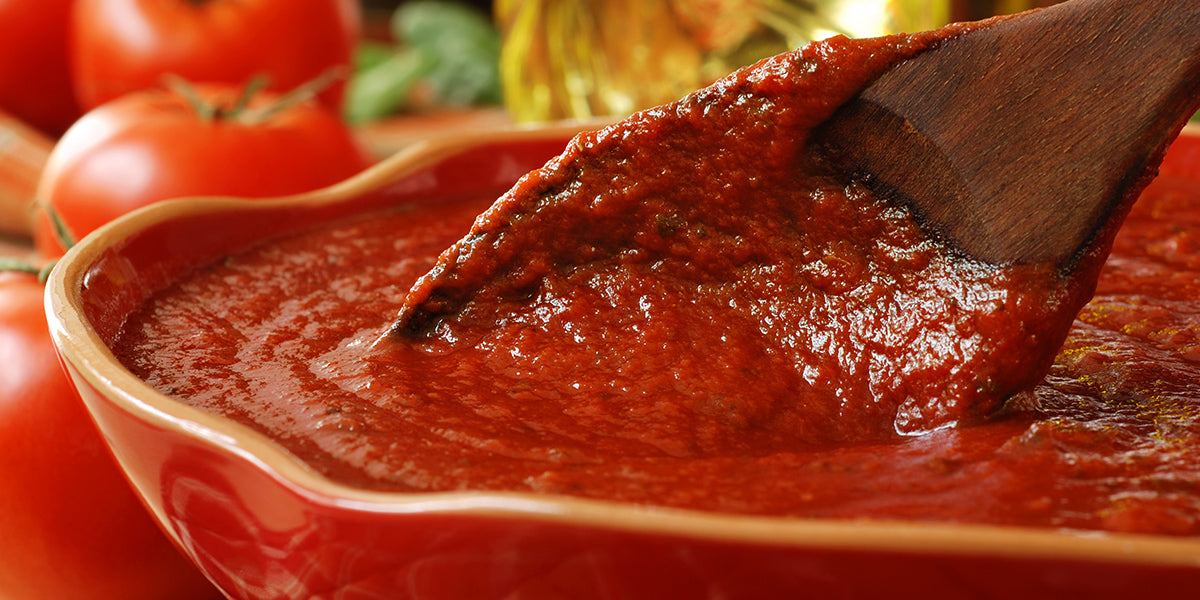
The Difference Between Pasta Sauce & Pizza Sauce
Do you know the nuances between different types of tomato-based sauces? Or does the sauce aisle leave you feeling a bit overwhelmed? From marinara to bolognese, the variety of tomato sauces is varied enough to set any chef’s heart on fire and just confusing enough to have an amateur home cook in tears. But not to worry. Use this guide to learn the key differences between all the red sauces you encounter on menus and store shelves.

The difference between pasta sauce and pizza sauce
If you’ve ever reached for a jar of marinara sauce in a pinch to top your pizza, then you know that pasta sauce CAN be used as a substitute for pizza sauce. This is especially true if using Otamot Essential Sauce, which is super fresh-tasting and on the thicker side already. But there IS a key difference between the two, and once you taste it, you’ll likely prefer pizza sauce for your pizza and pasta sauce for your pasta.
Quite simply, pizza sauce has a lot fresher, more raw taste than pasta sauce. This is because pizza sauce is barely cooked (sometimes not cooked at all), whereas pasta sauce is slow-simmered for hours to develop richness. Both sauces have a special purpose. Whereas the richness and sweetness of pasta sauce can make plain noodles sing, pizza sauce is more fresh tasting and plays a subtle, though highly important role, on a pizza.
If your pizza sauce is too thick or sweet, it can “take over” and make the entire pizza feel too heavy. A light application of fresh pizza sauce should make every bite of your slice taste brighter when the simple sauce hits your tongue. Otamot Pizza Sauce is designed to give pizza a fresh and light flavor boost (hello, delicious basil!) as well as a nutrient boost (it contains eight organic veggies!) without coming on too thick.

14 kinds of tomato sauce, and how they’re made
Some tomato-based sauces are chunky and include meat or seafood. Others are iconically spicy or smooth. Use this guide to learn what’s what when it comes to red sauce.
The World’s Best-for-You Pizza Sauce
Otamot did it again by packing nutritious veggies into an everyday staple sauce. Otamot Pizza Sauce is the only pizza sauce on the market made from 8 organic veggies plus basil. Here’s why this sauce is a game changer for pizza night:
- Plain cheese pizza gets better: If your kids, like many, will only eat cheese pizza, now you can ensure they get a boost from eight other veggies that they'll never know are hidden right in the sauce.
- High fiber, low sodium: Because of the added veggies, Otamot Pizza Sauce contains twice as much fiber (2 grams per ¼ cup) than other leading pizza sauces. Otamot has also reigned in the sodium, and it contains less than half as much sodium as other pizza sauce brands.
- No added sugar: As always, Otamot left out the added sugar (which is so ubiquitous in other sauces), instead getting plenty of natural sweetness from fresh tomatoes, butternut squash, carrot, sweet potato, and sweet onion.
- Nutrient boost: The added veggies in Otamot Pizza Sauce, including superstars like red beets, butternut squash, sweet potato, red bell pepper, carrot, sweet onion, garlic, and vine-ripened tomatoes, flood your bites of pizza with essential nutrients like vitamin A, K, E, B6, and potassium. The addition of extra-virgin olive oil means you're getting high-quality monounsaturated fat and no yucky inflammatory oils.
Otamot's Pizza Sauce is available only at Whole Foods Market for an exclusive time. Run to your nearest Whole Foods to try it on pizza tonight!

Jessie Shafer is a registered dietitian-nutritionist, team member at The Real Food Dietitians, former magazine editor, and busy mom of two who loves a good tomato-based sauce.


